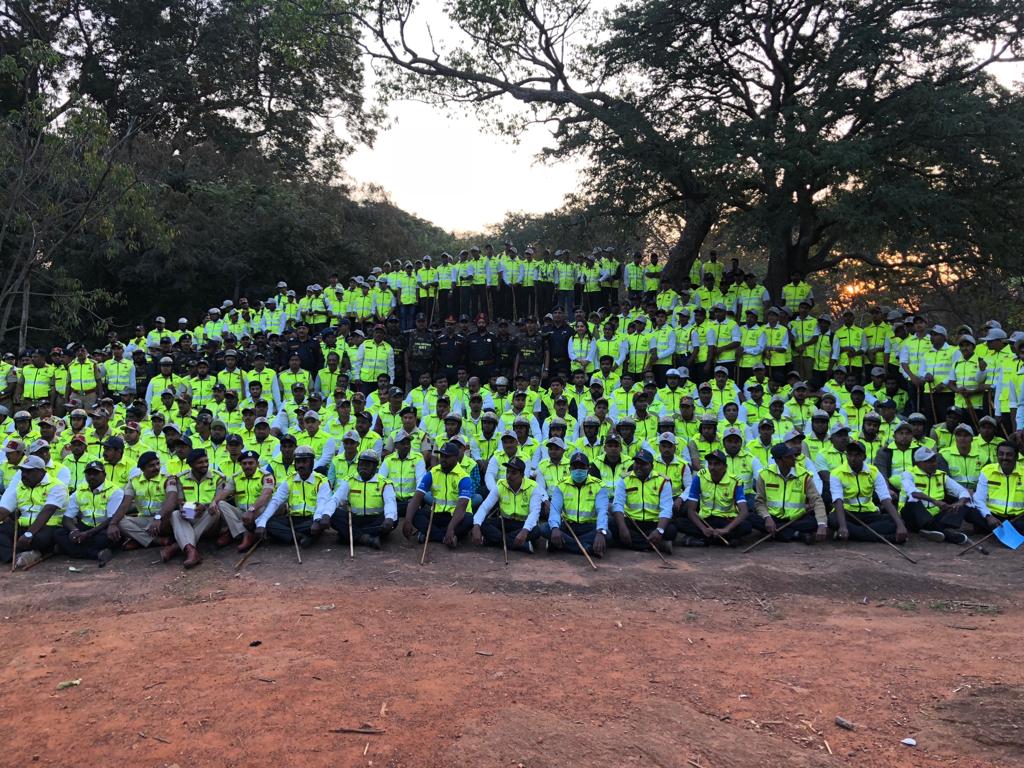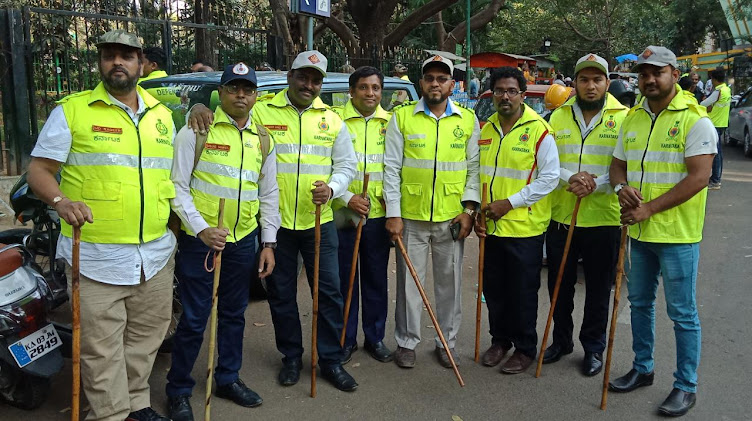Monday, April 12, 2021
the new Team of Division 17 from April 2021
Thursday, January 23, 2020
Brief Introduction to Karnataka Civil Defence
https://www.karnataka.gov.in/hgcd/english/Pages/home.aspx
CIVIL DEFENCE
Civil Defence is a voluntary organization functioning along with the Home Guards Organization. The Department comes under Home Ministry of Karnataka. The main object of this Organization is to protect life and property of the general public during external aggression & natural calamities. The volunteers have been enrolled and trained in basic Civil Defence and in various services aimed at implementation of Civil Defence measures. Government of India has declared Bangalore City. Mallapura in U.K.District and Shakthinagar in Raichur District as category II Civil Defence Towns in Karnataka and they have been continued as such during the year under report.
Civil Defence Measures are being implemented as per the paper plan by appointing Civil Defence controllers
The administration of the department is vested with the Director Civil Defence, Karnataka Bangalore. The DGP & Commandant General Home Guards holds this post as Ex-officio in addition to the responsibilities as Director General, Fire & Emergency Services, Karnataka State.
He is assisted by an Additional Director and a Deputy Director in the administration side. The IGP & Additional Commandant General Home Guards & The Deputy Commandant General Home Guards respectively hold these posts in addition to their Ex-Officio capacity.
The Commissioner of Police, Bangalore City, assist the Director of the organization as controller of Civil Defence, Head quarters service. The Deputy Commissioners of Uttara Kannada & Raichur Districts assist the Director as controllers for Civil Defence Activities at Mallapur & Shakthi Nagar Civil Defence Towns respectively.
The Civil Defence Activites are implemented under the Civil Defence Act and Rules 1968 enacted and framed by the Government of India. A Master Plan of Civil Defence has been published by the Government of India approving the staff pattern. A book titled Compendium of Instructions comprising reimbursement procedure of centre's share has been published by the Government of India. The General Principles of Civil Defence prescribes the services to be provided by the concerned State Governments as per the category of Civil Defence Towns in their State.
2 and 3. Mission / Vision of the Department:
The Civil Defence Warden Service in Bangalore is divided into 52 Divisions, the Department has a vision to appoint the minimum of 122 Civil Defence Wardens in each Division. The aim is to enroll 10,000 Civil Defence Wardens in Bangalore City. At present 7000 Civil Defence wardens have been enrolled. This will enable the Department to activate the other Services authorized for category – II Civil Defence Town in Bangalore. The department has vision to enroll one lakh volunteers for all the six services to be provided under the Civil Defence. Various Trainings are being proposed to Civil Defence Wardens enrolled to enable them perform various duties during Disasters. The Department has identified various strategic places like malls, theatres, schools visited by many people where mock drills may be conducted on various Disasters for the benefit of Civil Defence Wardens as well as the General public to face disasters both natural as well as manmade Disasters. Over 100 mock drills have been conducted and another 100 mock drills and demonstrations are in the pipe line in the present financial year. This will directly and indirectly spread awareness to about one lakh people in Bangalore.
The main objective of this Department is to save lives and minimize damage to property and maintain continuity of production. Civil Defence measures are an extension of the normal function of the various departments to suit emergent conditions and maintaining normal working in all spheres.
The Civil Defence measures include:-
a) Education and Training.
Civil Defence Act – 1968.
1. Title – Civil Defence Act – 1968
Civil Defence rules, 1968.
The Civil Defence rules 1968, lay down the rules to be followed by Civil Defence Wardens in the course of performing their duties Shown below are the duties performs during disasters as mentioned below:
1. Control of lights.
2. Measures for dealing outbreak of fires.
3. Camouflage.
4. Keeping of dangerous articles and substances.
5. Evacuation.
6. Accommodation off evacuated persons.
7. Billeting.
8. Power to Slaughter dangerous animals.
9. Maintenance of water supply.
10. Power to require local authorities to take precautionary measures.
11. Protection of major ports and environments.
12. Protection of factories and mine.
13. Precaution against hostile attack.
14. Watching of premises to detect fire.
15. Safety measures in premises.
16. Prevention of spread of diseases.
17. Air raid shelters.
18. Civil Defence exercises.
Monday, July 15, 2019
Civil defence Savandurga Trek
many wardens from Various Divisions participated in this trek.
the trek was led by Sunand Sampath
Saturday, March 9, 2019
Sanrakshan Newsletter 2nd edition
this edition also has a special message from our Respectful Officer Commanding HA , Dr P R S Chetan .
Download the newsletter second edition o9f SANRAKSHAN
regards
Sunand Sampath
Division 17 Newsletter
one such initiative is the newsletter Sanrakshan
edition i is attached , please download the newsletter and share it widely
DOWNLOAD THE fIRST EDITION OF NEWSLETTER
Click the Above Link
Sunand Sampath
Friday, June 15, 2018
Hazard classification System
A very important information for managing industrial disaster . hazard classification .
HAZARD CLASSIFICATION SYSTEM
The hazard class of dangerous goods is indicated either by its class (or division) number or name.
Placards are used to identify the class or division of a material.
The hazard class or division number must be displayed in the lower corner of a placard and is required for both primary and subsidiary hazard classes and divisions, if applicable.
For other than Class 7 placards, text indicating a hazard (for example, “CORROSIVE”) is not required. Text is shown only in the U.S. The hazard class or division number and subsidiary hazard classes or division numbers placed in parentheses (when applicable), must appear on the shipping document after each proper shipping name.
Class 1 - Explosives
Division 1.1Explosives which have mass explosion hazard
Division 1.2Explosives which have a projection hazard but not a mass explosion hazard
Division 1.3Explosives which have a fire hazard and either a minor blast hazard or a minor projection hazard or both, but not a mass explosion hazard
Division 1.4Explosives which present no significant hazard
Division 1.5Very insensitive explosives with a mass explosion hazard
Division 1.6Extremely insensitive articles which do not have a mass explosion hazard
Class 2 - Gases
Division 2.1Flammable gases
Division 2.2Non-flammable, non-toxic* gases
Division 2.3Toxic* gases
Class 3 - Flammable liquids (and Combustible liquids [U.S.])
Class 4 - Flammable solids; Substances liable to spontaneous combustion; Substances which, on contact with water, emit flammable gases
Division 4.1Flammable solids, self-reactive substances and solid desensitized explosives
Division 4.2Substances liable to spontaneous combustion
Division 4.3Substances which in contact with water emit flammable gases
Class 5 - Oxidizing substances and Organic peroxides
Division 5.1Oxidizing substances
Division 5.2Organic peroxides
Class 6 - Toxic* substances and Infectious substances
Division 6.1 Toxic*substancesDivision 6.2Infectious substances
Class 7 - Radioactive materials
Class 8 - Corrosive substances
Class 9 - Miscellaneous dangerous goods/hazardous materials and articles
* The words “poison” or “poisonous” are synonymous with the word “toxic”.
Content collected from various sources .
Sunand Sampath.
Saturday, June 2, 2018
Training and awareness By Civil Defense
training on the below topics was delivered to various institutions
1. Basic Life Support
2. Golden Hour
3. CPR
4. DFisaster Management
Some of the organizations where these trainings were given by Sunand Sampath are
HAL Helicopter division
BOSCH
MLA College various batches
NSS Cadets of Bangalore University
Chamundi Scouts and Guides
Manipal Center for learning
Rotary Club
Many schools and colleges

As on this date total participants reached through these trainings is 4000.
signing out
Sunand sampath










































